Cosmetic Bonding
Are There Any Disadvantages?
The acrylic materials used in bonding do not last as long as your typical crown. Bonds will eventually chip or become discoloured. The bonded plastic coating can break off if you bite down on something hard or accidentally fall and bump your tooth.
Bonds last an average of five years, and are also more susceptible to stains than compared to your natural teeth. Smoking cigarettes, drinking tea or coffee and even eating blueberries may cause some discolouration.
Your Patient Guide
Cosmetic Bonding
In Summary
Whether your damaged teeth are a result of decay, dark fillings, a swinging door or a bicycle mishap, bonding can give you something to smile about.
Resin bonding can be used for:
- Space Problems
- Chipped or Broken Teeth
- Stained Teeth
- Stabilizing Teeth
- Replace Missing Teeth Changing Colour or Shade
- Cosmetic Repositioning.
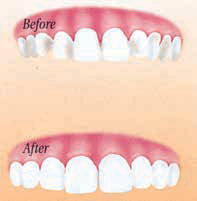
It is now possible to whiten stained teeth and replace fillings with bonded material. The results are tremendous.
What Is Cosmetic Bonding?
Cosmetic bonding, often called resin bonding, is when a tooth coloured resin is bonded to your teeth, then sculpted into the proper shape. The resin is a composite of liquid acrylic and tiny particles of glass. The composite resin forms a durable, stain-resistant surface that can be polished to mimic the texture of your natural teeth.
With advances in modern dentistry, there is no reason you should be unhappy with the way that your teeth look. Psychologists have proven that a beautiful smile enhances your personal appearance and improves your self confidence. If you don’t like your teeth, cosmetic bonding may be the right solution for you!
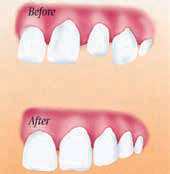
An acrylic resin is bonded to the tooth and sculpted into the proper shape.
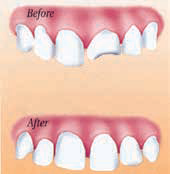
Acrylic bonding is a great solution for chipped teeth.
Did You Know?
Cosmetic bonding, often called resin bonding, is when a tooth coloured resin is bonded to your teeth, then sculpted into the proper shape.
When Is Cosmetic Bonding Used?
In the past, if your tooth was chipped, stained or cracked, you would probably receive a crown. Today bonding is a quick and easy solution for many of these problems.
For example, by lightly filling a tooth on one side and building it up on the other, your dentist can eliminate the gap from a gap-toothed grin. By adding thickeners to vary the consistency, dentists can use the resin-like clay to restore chipped or broken teeth or as a putty to fill in cavities. In fact, worn or darkened “silver” fillings can be replaced with tooth-coloured bonding materials that are indistinguishable from your natural tooth enamel. One type of resin is even used as a sealant to shield the back teeth from decay.
Bonding is used to whiten stained teeth, to stabilize loose teeth, and to replace missing teeth. With resin bonding, you can change the colour, the shape and the position of your teeth, improving your smile. While bonding is a wonderful technique, it will not solve all restorative dental problems. Where a large portion of the tooth surface is damaged, a veneer or crown may be more advisable.
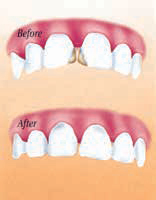
Defects in the enamel of the primary and permanent teeth can be corrected by painting on the resin as a sealant. This helps prevent decay.
What Is The Procedure For Bonding?
Because the tooth surface is left intact, bonding isn’t painful and doesn’t harm the tooth. The procedure is normally completed without local anaesthetic or tooth preparation. In most cases, bonding requires only one visit to the dentist.
To bond a tooth, the surface of the tooth is etched with a mild acidic solution. This creates micro pores in the enamel, making the tooth more porous and receptive to the plastic bonding material. Next, the soft, pliable resin is spread over the tooth in layers. A bright beam of light locks the resins onto the tooth surface. Each layer hardens in minutes. After the last coat has been applied and hardened, the bonded material is shaped and polished. The resin comes in many shades. Your dentist will match the resin to the shade of your natural teeth.

A gap is easily eliminated with bonding material.
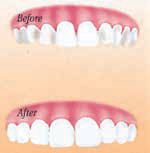
The bonding resin comes in many shades so that it can match your natural teeth.
What Our Patients Say?
We accept all major insurance plans.
We accept a number of insurance plans to help cover the cost depending on your individual needs.
